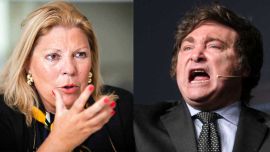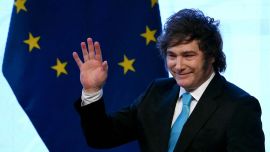Argentina’s government finally hit the panic button.
After years of trying to avoid a currency devaluation that would add to soaring inflation and reduce its popularity with voters, on Monday it did just that. The move was an admission by President Alberto Fernández that his administration had run out of options — and money — to defend an unsustainable exchange rate after suffering a stinging defeat in a crucial primary election on Sunday.
The 18 percent devaluation takes the official peso rate to 350 per dollar, compared to 287-per-dollar on Friday, and comes with another huge hike in the Central Bank’s key interest rate. It was lifted 21 percentage points to 118 percent.
The drastic decisions will do little to calm investors, with Argentine assets slumping since the stronger-than-expected performance on Sunday by libertarian candidate Javier Milei, who wants to dollarise the economy and abolish the Central Bank.
Argentines who don’t have access to dollars in the official market raced to buy them in the parallel market on the streets of Buenos Aires, pushing the rate down as much as 12 percent to around 690 pesos per dollar, according to website dolarhoy.com. The nation’s bonds, already deeply distressed, led declines across emerging markets. Stocks also sank, with a US-traded ETF at one point plunging the most since March 2020 before trimming losses.
Fernández is well aware of the risks that the devaluation brings. Less than a month ago, Fernández told Bloomberg Television that “an abrupt devaluation would be a problem for Argentina.” Without winning the trust of the investing community first, the move could fan a devaluation-inflation spiral that is difficult to break. Inflation is already running at a 115 percent annual pace.
In Argentina, a country with a hyperinflation past and a rate of price increases nowadays of six percent per month, it takes little time for political turmoil and market tumbles to spill into the real economy. On Monday morning, there were already preliminary reports that some business suppliers were ratcheting up their prices, adding to the growing sense of crisis in the country ahead of the October 22 presidential election.
“We’re in a context of very low credibility so we expect monthly inflation in August or at the latest September to enter the double-digit territory. Two digits means 10 percent easily,” Gabriel Caamano, economist at Buenos Aires-based Consultora Ledesma.
To a certain degree, Monday’s drama supports the argument espoused by Milei, a libertarian who believes Argentine government officials are incapable of properly managing the country’s money supply and controlling inflation. Milei, who is now the frontrunner going into October’s general election, proposes a drastic reduction of government spending and taxes, privatising deficit-making public companies and eventually getting rid of its autonomous monetary policy.
While his electoral success — he came out first of the primary with about 30 percent of votes — shows his rightist agenda resonates with Argentines tired of government prodigality and economic disasters, at the same time his lack of executive experience and an expected divided congress opens questions about governability. Argentina also has a history of monetary decisions — such as pegging the peso to the dollar in the 1990s — that didn’t end well.
For the ruling Peronist coalition, coming out third — behind the more business friendly opposition — is a disastrous result because it confirms there will be a three-way race in October, with an increasing chance of a run-off in November between the top two candidates. The government’s contender, Economy Minister Sergio Massa, will now have an even steeper path to qualify for a run-off, given how the devaluation will likely hit Argentine consumers hard.
Problems don’t end here for Massa, who will also have to face a complicated US$44-billion agreement with the International Monetary Fund with diminished political clout. The IMF’s board still has to approve a US$7.5-billion disbursement to the country that was expected to arrive in the second half of August, with a meeting now planned for August 23.
The peso devaluation is probably one of the key conditions behind the negotiations with the IMF, according to Alberto Bernal, XP’s chief institutional global desk strategist.
“It reduces somewhat the pressure on the external accounts and while it will generate more recession and higher inflation, there is no alternative,” he said. “It’s bad news for Massa as it increases the probability that he does not make it to the run-off.”
The new official exchange rate of 350 pesos per dollar is the wholesale price for companies and banks but it’s hardly the only factor affecting currency movements and inflation expectations.
The state-own Banco Nación also adjusted its retail peso value to 365.50 per dollar, from 298.50 on Friday, with the Central Bank pledging to keep that level unchanged until the election in an attempt to contain further devaluation fears.
Argentina's Central Bank, which confirmed the rate hike in a statement, also raised the one-day passive repo rate to 111 percent this Monday, from 91 percent, and the one-day active repo rate to 140 percent, from 116 percent. The Economy Ministry in Buenos Aires referred questions to the Central Bank.
by Ignacio Olivera Doll, Scott Squires & Manuela Tobias, Bloomberg






















Comments